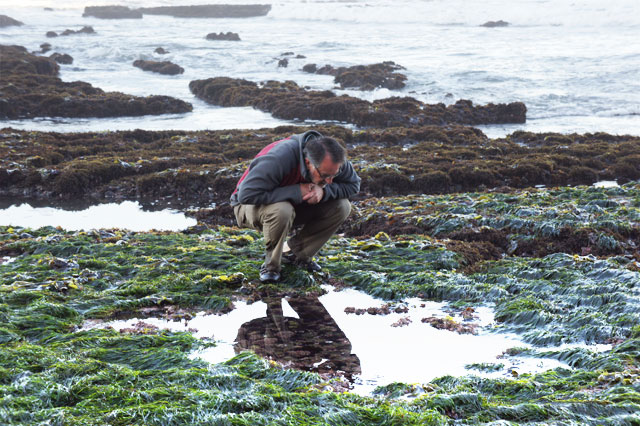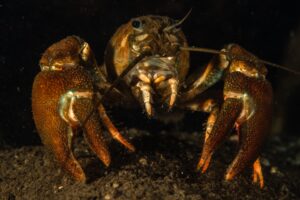The Smithsonian Channel will debut a new nature documentary this Sunday evening with the cheerful title Mass Extinction: Life at the Brink. The news won’t surprise people who follow nature: life on Earth is in decline, in a dramatic sort of way. Many have begun to label this human-caused catastrophe the Holocene Extinction or the Sixth Extinction, tying the modern event to five previous mass die-offs that claimed most of the species on Earth at the time.
I exchanged emails with two of the film’s expert witnesses, UC Berkeley paleoecologist Anthony Barnosky and Stanford biologist Elizabeth Hadly, to ask if we’re at the brink — or already over the edge.
Q: Professor Barnosky, you have a line in this film that says, “if we continue to do things the way we do today, a sixth extinction is virtually certain.” How far down the path toward a sixth mass extinction are we, and what chance do we have of avoiding one?
A: The rate of extinction we’ve seen over past decades would take us to a mass extinction within a couple of human generations, which is very bad news. But the good news is, despite decimating the numbers of individuals in thousands of species, we’ve so far caused total extinction of less than one percent of the species that have been on the planet with us over the past 12,000 years. So we still have most of what we want to save, though it’s going fast if we continue business as usual. We can still avoid the sixth mass extinction by stepping up conservation measures, dealing with climate change, producing food more efficiently, and integrating nature into our economic systems. We know how to do all these things, we just have to decide we want to. But it’s important we start today, because every day we wait pushes us closer to the point of no return.
To understand whether we’re in a mass extinction or not relies on calculating present day extinction rates and comparing them to the historical record. How do you calculate an extinction rate?
Basically, you look at the proportion of species that goes extinct over a certain interval of time, compared to the number of species that lived during that time. We can determine what rate of extinction is normal over millions of years by compiling data from the fossil record. We can then see how that normal rate compares with the proportion of extinctions that we’ve caused over the past few centuries. The bottom line when you do that is that humans have been driving species to extinctions tens of times faster than normal — keeping up that too-fast extinction rate would mean we reach the mass extinction benchmark within a couple of centuries, if not sooner. (For a good explanation of how we compare fossil extinction rates with current ones, see this video on Biointeractive.)
And what does the present rate look like compared to the background rate?
Based on the best data available, which is for mammals, empirically determined from a detailed study of the fossil record, the background rate is 1.8 extinctions per million species per year.
The current rate for mammals calculated over the last century is between 50-75 extinctions per million species per year, depending on what assumptions you make in your extinction counts.
These numbers would mean that the current rate for mammals is at least 27 times too high.
For all ~75,000 species that have been assessed for extinction by the International Union for Conservation of Nature, the extinction rate measured over the last 500 years (about 897 extinct species in that time that we know about), is about 24 extinctions per million species per year, or about 12 times too high with respect to the background rate calculated for mammals.
Often in stories about extinction you’ll see figures like rates are 100, 1,000, or even 10,000 times too high. That’s because people in the past have tended to use a very back of the envelope estimation of background extinction rates that involved lots of assumptions about how long mainly near-shore marine invertebrate genera, like clams and snails, lived over the past 600 million years. Those estimations ended up with background rates of between 0.1 and 1.0 extinctions per million species per year, much lower than the empirically determined background rate from mammals. The lower the background rate you use, the more extreme the current extinction crisis looks.
I use the mammal-determined rates because it is the best data available, and because most of the comparisons being made when we talk about the current extinction crisis are for vertebrate animals, which are more likely to have background extinction rates similar to mammals rather than to invertebrate marine species. Even with this conservatively assessed background rate, the current extinction crisis looks dire.
Are the extinctions taking place right now evenly distributed around the world?
No. It’s of great concern that highest extinction rates are in the relatively small pieces of real estate that contain most of the world’s species, places like tropical forests and coral reefs. Such ecosystems are exactly the ones that are in most peril from future pressures as well.
What makes some areas more resilient than others?
Basically, places where humans have already caused lots of extinctions by modifying the landscape and seascape to suit our needs will be most resilient to ongoing human impacts. That’s simply because the species that couldn’t take the pressure there already are gone. Least resilient as we go into the future will be species that depend upon the specialized habitats in which they evolved—again, places like tropical forests and coral reefs, which we are destroying at a rapid pace by things like deforestation, overfishing, climate change, and pollution.
As the film implies at the beginning, we tend to think of extinction events as sudden: an asteroid hits, a volcano erupts, everything dies. Is it that bang-bang? What is the time scale for a mass extinction?
For the dinosaurs, it was ultimately one particularly bad day. But even for that one, the downstream effects that led to the magnitude of extinction observed, around 75% of the known species, probably took at leas a few decades after the asteroid hit. For the end Permian extinction, when more than 90% of known species seem to have bit the dust, it was probably a much more “gradual” process, with losses accumulating over a few thousands of years. Our present extinction crisis is particularly severe in terms of rapidity—a rate of loss that would lead to mass extinction in a couple of centuries or less, which we are seeing today, seems to be much, much faster than at least four of the other five mass extinctions we have evidence for in the geological record.
At the end of the film, it asks the tough question: so what do we do?
First, it’s incredibly important to shift over to carbon-neutral energy production as fast as possible—we need to get there by mid-century. That’s because the speed and magnitude of climate change caused by our present use of fossil fuels is outside the bounds of what most living species have experienced in since they first evolved, and they simply can’t move or adapt fast enough.
Second, we have to be more efficient in how we produce enough food to feed seven billion people today, growing to over nine billion by mid-century. Already humans have transformed nearly 50% of Earth’s land into something not suitable for many of the species that originally lived there. Most of that is for agriculture. Fortunately, it is possible to increase yields in many existing crop and pasture lands through environmentally sound new agricultural practices, and we can also make much, much more food available just by eating less meat and reducing the food that is wasted. Such measures are going to be necessary to avoid taking over the few remaining natural habitats, like tropical forests, for agriculture.
Third, we have to start viewing the economic value of nature more like an investment account where we live off the interest, rather than as a checking account that will never run dry. This means putting a monetary value on things we get back from other species, like clean air, fertile soils, and recreational opportunities, and integrating that into world financial markets.
Fourth, we have to do more of the things that conservation biologists have already been doing to save species, like ensuring that suitable habitat remains, nursing ailing species back to health, and re-thinking the goals of many of our species reserves to bring them into alignment with the realities of the rapid global change we’re witnessing today.
And, I probably can’t overemphasize the necessity of keeping the human population from going past where it’s inevitably headed by mid-century, between 9 and 10 billion people. A very effective way of doing that is simply to ensure education and health care for women throughout the world, which tends to bring down birth rates. Ultimately, the more of us there are, the larger the drain on resources that other species also need to stay alive.
Climate change and human development put pressure on almost every organism on Earth today, and estimates still suggest that 90% of species are undiscovered. With so much at risk, how do you make effective decisions about any particular species? Why should it matter to someone who’s never heard of, for example, the endangered salt marsh harvest mouse of San Francisco Bay if the mouse goes extinct?
One problem is, ecosystems are so incredibly complex that we still don’t know which species are the glue that holds everything else together, and which ones might disappear without obvious ecological consequences. Oftentimes the only way we find out is when a species goes extinct, and by then it’s too late of course. We do know that some species are so-called keystone species, and if you get rid of those, then many other species quickly suffer as well. Obviously those are important to save. Another way to look at is through an economic and human-health lens: we don’t know how most species are going to benefit humans directly until we learn more about them—cases in point being many species that provide life-saving drugs for us and billions of dollars for the pharmaceutical industry, among them certain deadly snakes. But there’s a more human way to look at it too. Each species is unique and wonderful, the one-of-a-kind product of millions of years of evolution. Choosing which one to let go extinct is kind of like choosing which of Rembrandt’s paintings it would be OK to burn.
Mass Extinction: Life at the Brink airs Sunday at 8 p.m. eastern on the Smithsonian Channel.
Anthony Barnosky is a professor in the Integrative Biology Department at UC Berkeley and author of a new book from the UC Press, Dodging Extinction.
Elizabeth Hadly is a professor in the Biology Department at Stanford and a senior fellow in the Stanford Woods Institute for the Environment.





